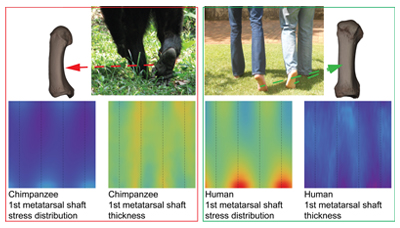martes, 17 de marzo de 2015
Big toe’s big bone holds evolutionary key
Our skeletons hold tell-tale signs that show that human bipedalism – walking upright and on two feet – are unique to humans especially when compared to our closest living relatives, apes. Exactly when these signs first appear in our evolutionary history is one of the fundamental questions driving the study of human evolution, or Palaeoanthropology, today.
An interdisciplinary team led by scientists at the University of the Witwatersrand in Johannesburg, South Africa, has combined visualisation techniques, engineering principles, and statistical analysis into a powerful new way of analysing the structure of long bones.
In the initial study, titled Cortical structure of hallucal metatarsals and locomotor adaptations in hominoids, and published in the open access journal PLoS One, the group of scientists documents foot differences between living humans and other apes that will be a starting point for their future studies investigating how far back in our evolutionary history the modern human pattern of bone structure in the hallucal metatarsal emerged. [...] wits.ac.za/ / Link 2
Suscribirse a:
Enviar comentarios (Atom)








No hay comentarios:
Publicar un comentario